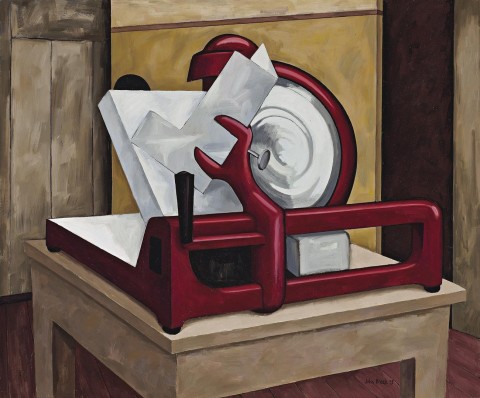STILL LIFE WITH SLICING MACHINE, 1955
JOHN BRACK
oil on canvas
63.5 x 76.5 cm
signed and dated lower right: John Brack 55
inscribed on frame verso: John Brack Meat slicing Machine
Australian Galleries, Melbourne
Miss D. Rachor, Melbourne,
acquired from the above in 14 February 1958
Leonard Joel, Melbourne, 24 July 1986, lot 1195
Private collection, Melbourne
Deutscher~Menzies, Melbourne, 10 August 1998, lot 133 (as ‘Meat Slicing Machine’)
Private collection, Melbourne
Christie's, Melbourne, 1 May 2000, lot 292
Private collection, Brisbane
Bonhams & Goodman, Melbourne, 6 May 2009, lot 48
Private collection, Sydney
John Brack, Peter Bray Gallery, Melbourne, 19 – 29 March 1956, cat. 7
Contemporary Australian Painters, shown at eight Canadian public galleries, 1957 – 8
Australian and Australia-Related Art: 1830 – 1970s, Deutscher Fine Art, Melbourne, 25 November 1987, cat. 161 (illus. in exhibition catalogue)
John Brack: A Retrospective Exhibition, National Gallery of Victoria, Melbourne, 10 December 1987 –31 January 1988, cat. 31 (label attached verso)
John Brack Retrospective, National Gallery of Victoria, Melbourne, 24 April – 9 August 2009; Art Gallery of South Australia, Adelaide, 2 October 2009 – 31 January 2010
Millar, R., John Brack, Lansdowne Press, Melbourne, 1971, p. 106
Lindsay, R., McCaughey, P., and Hoff, U., John Brack: A Retrospective Exhibition, National Gallery of Victoria, Melbourne, 1987, pp. 117, 119
Rooney, R., ‘Brack’s no need for Ballyhoo’, Weekend Australian, 19 – 20 December 1987, p. 10
Grishin, S., The Art of John Brack, Oxford University Press, Melbourne, 1990, cat. o49, vol. 1, pp. 51, 59, 187, vol. 2, p. 97 (illus.)
Dedman, R., ‘Market Profile: John Brack’, Art and Australia, Sydney, vol. 44, no. 2, Summer 2006, p.295 (as ‘Slicing Machine’)
Grant, K. (et al.), John Brack, National Gallery of Victoria, Melbourne, pp. 42 (illus.), 215
Upon his discharge from the army in 1946 John Brack resolved to pursue a career as a professional artist. Further studies at the National Gallery School under the Commonwealth Reconstruction Training Scheme provided him with technical knowledge and practical skills, as well as a community of like-minded artists including Sam Fullbrook and Fred Williams. In his mid-twenties, Brack had emerged from the army with what his wife, Helen Brack, described as ‘a personal maturity … authority … a kind of endurance [and] discipline that made him a force to be reckoned with’.1 His experiences had also equipped him with a strong personal philosophy and clear vision of the kind of artist he wanted to be. In addition to being actively engaged with the world around him, Brack believed that grand statements were no longer relevant and instead, encouraged by the example of favoured literary figures such as Henry James and Rainer Maria Rilke, chose to focus on subjects that were local and familiar.
From the glowing interior and smiling mannequins of Men’s Wear, 1953 (National Gallery of Australia, Canberra) to the ordered domesticity of The New House, 1953 (Art Gallery of New South Wales, Sydney) and everyday routine of Collins St, 5p.m., 1955 (National Gallery of Victoria, Melbourne), major paintings of the early 1950s depicted subjects that viewers recognised from their own lives in the city and suburbs and established Brack’s reputation as an acute observer of contemporary Australian life. Critics typically found them funny and characterised Brack’s approach as primarily satirical, missing the deliberate irony and layers of allusion and meaning embedded in his compositions. As Brack later said, his paintings were ‘part of a metaphorical system … intended to operate on numerous levels of meaning (and) … to have some reference to the complexity of life’.2
Still life with Slicing Machine, 1955 and the closely related work, The Slicing Machine Shop, 1955 (private collection) were made in response to Brack’s encounter with a shop at the top of Bourke Street, in the centre of Melbourne, which sold commercial kitchen equipment. The larger view of the shop depicts a conglomeration of measuring scales, giant mixers and slicers with gleaming blades and spikes that together, assume frightening anthropomorphic qualities. In this picture the view has been pared back to focus on the slicing machine alone, its shiny silver surfaces contrasting with the rich burgundy red of its frame. The machine almost completely fills the picture’s space but its placement is slightly off-centre, leading the eye towards a doorway to the right which appears as a dark and potentially menacing void. Precursors to Brack’s well known series of shop window paintings of the early 1960s which, through the depiction of surgical instruments and prosthetic aids enabled him to comment about human life without depicting the figure, these earlier paintings also alluded to meanings beyond the surface. As Helen Brack recalled, ‘While students, we were half aware of double images [and realised] … that visual analogy is part of the language of art. In the early 1950s the reality of the Holocaust was felt here in Melbourne, it was past understanding or imagination, and John was compelled to comment because it had happened in our time … The Block, 1954, is the first of these visual essays, followed by The Lift, 1954, then the two slicing-machine pictures, Self-portrait, The Sewing Machine, The Fish Shop, all from 1955 … and perhaps the final one is The bird lady, 1958’.3
1. Brack, H., ‘A tribute to John’, speech delivered at the National Gallery of Australia, Canberra, 16 February 1999, transcript, National Gallery of Australia Research Library, Canberra, p. 2
2. Brack, J., interview, Australian Contemporary Art Archive, no. 1, Deakin University Media Production, 1980, transcript, p. 3
3. Brack, H., ‘This Oeuvre – The Work Itself’ in Grant, K., et al., John Brack, exhibition catalogue, National Gallery of Victoria, Melbourne, 2009, p. 12
KIRSTY GRANT
